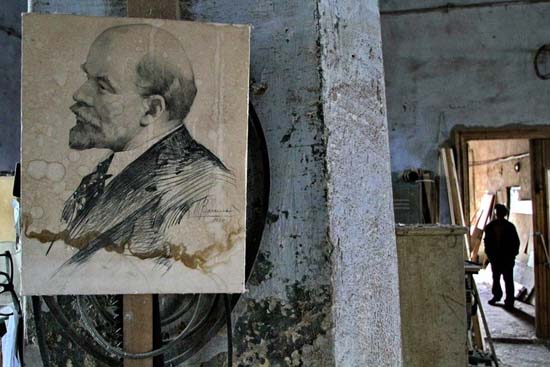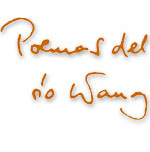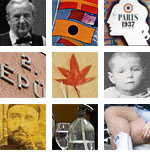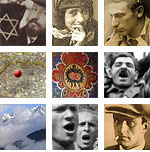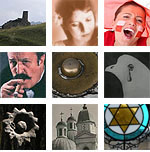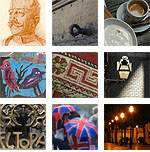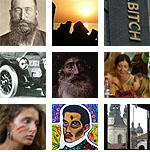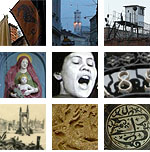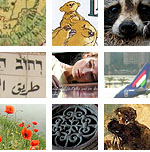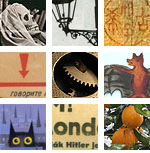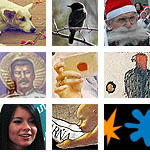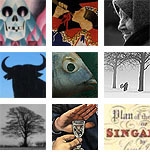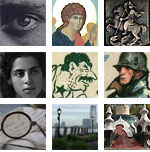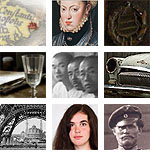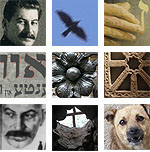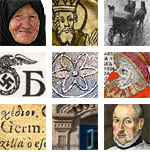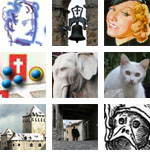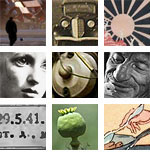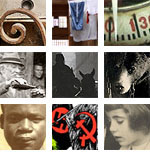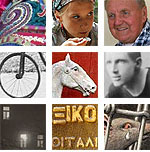• Prologue
 Belle époque
Belle époque
• The future, a century ago
• Cartes de visite
• The language of stamps
• The first bicycles 1. 2. 3.
• A black man in Hamburg
• Black people in the zoo
• Ghosts on old photos 1. and 2.
The Austro-Hungarian Monarcy
• The tastes of the Monarchy 1. and 2
• Hawelka in Vienna and Krakow
• Un ristorante in Abbazia
• I, Anna Csillag: ads from Schulz to Hitler
• Beginnings of the Hungarian railway
• The Casino of Kőbánya
• Hundred years of a tree in Kőbánya
• Pharmacies in Kőbánya
• The Golden Eagle Inn in Pest
• Cartolina da Budapest a Firenze, 1900, e la Tabán sparita
• Temperance campaign at the turn of the century
• Shutter labels: Korányi and Fröhlich, Paschka, Sándor Árkai, Czernowitz, Lemberg and Żółkiew
• A former passage in Lwów
• Multi-ethnic house in Lemberg
• Century-old brick graffiti in Budapest
• “King Matthias’ palace” in Kassa, 1899-1943
• Bram Stoker’s hotel in Beszterce
• Vampire-killing sets for a Transylvanian journey
• Hungarian Armenians
• Art Nouveau in Szabadka
• Szabadka 1912-ben, 1. 2. 3. 4.
• An Indian in Szabadka
• The last postcards of the Monarchy – from Odessa
• The Austro-Hungarian army, 1914
Germany
• Passion play in Oberammergau
• Immagini di vecchie estati
• Un’escursione di Pentecoste
Britain
• The Oxford Arms Inn and old London
• Ghosts in the photos of old London
France
• Figures in old photos of Paris
• Henri Roger-Viollet, Paris
• The Luna Park in Paris
• Building and apotheosis of the Eiffel Tower
• Train accident, 1895
• The last Tsar in Paris, 1896
• Zuavs in the French colonial army
• The Fifer Boy in the imperial army
• French primer of geography, 1905
• Az 1910-es nagy párizsi árvíz
Italy
• Childhood of an Italian patriarch
• The first hydrocycle
• The Messina earthquake, 1908
Spain
• Photos of dead children
• Old Palma in the photos of the Escalas archive
• Palma: The first velocipedists
• Palma: The Born Passage and Edison’s voice
• The rural world of Mallorca
The Russian empire
• Alexander Roinashvili, the traveler
• Dmitry Ermakov, chronicler of the Caucasus
• Ernest Chantre’s Caucasian photos, 1881
• Flood of the Kura in Tiflis, 1893
• Qajar houses in Tiflis
• Ivan Boldyrev: Don Cossacks, 1875-76
• Marriage ad with a balance
• Moscow’s fire brigades 1. and 2.
• Constructing the Trans-Siberian Railroad
• Sakhalin, 1894-1905
• Bike on the dacha
• Three Russian family photos from Ekaterinoslav, 1914
• Three generations on Russian photos
• Russian photos from Odessa
• Culture of Odessa in the early 20th c.
• The blossoming and end of Jewish Odessa
• The Russian army, 1892
• Russian sailors at the Messina earthquake, 1908
• Moscow in 2259
• Russian slides by František Krátký, 1896
• The coronation of the last Tsar, 1896
• The last Tsar in Paris, 1896
• The last day of the peace
The Ottoman empire
• An Ottoman shoebox
• Damascus anno
• Photographers of the East
• Turkish-Hungarian friendship
The Persian empire
• Ahmad Mirza, the last Qajar Shah
• Sándor Kégl, Iranian scholar
• Qajar houses in Tiflis
The Heavenly Empire
• Studio Po-Chou, Hong Kong, 1897-ben
Jews
• Yinglish shop label in New York
 Great Games
Great Games
• The Gulistan Treaty
• The exiles of the Boer war
 The Great War
The Great War
• The attempt in Sarajevo in the Russian press
• The cut photos of the attempt in Sarajevo
• To My Peoples
• Soldiers’ trains 1. és 2.
• Cartoline rosa dalla fronte a Óbuda per sei anni, 1.
• The Europeana 1914-1918 project
• Conquering eveywhere. War ad of the Pathé Brothers
• Versions of the “pointing” recruiting poster
• British and Russian children’s propaganda
• German military children’s books
• Preparation for the war with paper soldiers
• Bathing little Venus, delight of children soldiers
• Krampus and red devils on the front
• Soldiers’ cemetery in the Carpathians (Tatariv)
• An evangeliary from Galicia
• The Jews of Podhajce greeting Archduke Frederick, 1916
• The Jews of Kolomea greeting Charles IV, 1917
• Generals in Lemberg’s Café Sztuka
• Statues of Hungarian and Romanian heroes in the Carpathians
• Songs from the two banks of the Isonzo
• Austro-Hungarian artillery in the Holy Land
• The five graves of Captain Truszkowski
• Jews in WWI. Exhibition of the Vienna Jewish Museum, 2014
• Jewish military cemetery at Gorlice
• Kraftwagenpark 505: German soldiers in the Holy Land 1. and 2.
• People of Véménd in Béla Hernai’s photos, 1916-1918
• Christmas greetings by Russian POWs to Sándor Kégl
• Photo cut in two in Valenciennes
• Merry-making at the news of Russia’s withdrawal from the war
 Strange peaces
Strange peaces
• New borders in Europe
• The Hutsul Republic
• Una scuola alla frontiera: Temesvár/Timișoara
• Stemma ungherese sul parlamento croato, 1918
• The Moravians in Hultschin, who said no to Czechoslovakia
• Plebiscito falso su Subcarpazia
 The Mexican revolution
The Mexican revolution
• The Casasolas, chroniclers of the revolution
• Songs of the revolution
• José Guadalupe Posada, drawer of the revolution
• Holy pictures of the revolution
 The world revolution
The world revolution
• Photos of the February revolution in the Dicescu collection
• Retouched postcards of the February revolution
• True pictures of the October revolution
• Vladimir Fedorov’s revolutionary cartoons, 1917
• Lenin’s Transylvanian bodyguard
• The fate of an officer’s family
• Fleeing Russia
• The birth of the Soviet Union and the Council of People’s Commissars
• Eugenetics in the Soviet Union
• Boris Kustodiev’s processions
• Boris Kustodiev’s great leap
• Mayakovsky, lighthouse of the revolution
• World revolution for children
• Day of Birds and other parades
• The NEP period and its songs, 1921-1928
• Soviet Photo, 1926
• Yuri Yeremin: Moscow, 1926
• Branson De Cou: Moscow, Peterhof, Tsarskoe Selo, Odessa, 1931
• Ilya Ilf, Russian and American photos
• Kommunalki
• Two New Year photos from Russia
| |
 War against the alcohol
War against the alcohol
• Hungarian and French campaign at the turn of the century
• Soviet temperance posters, 1920-1991
• Say no! Metamorphoses of the poster of 1954
• Polish temperance posters
• With temperance posters against Coca-Cola
• With luboks against the alcohol, 1989
 Between two wars
Between two wars
• The golden age of Hungarian photography
• Hassids in Subcarpathia
• Polish Jews: Alter Kacyzne
• Polish Jews: Roman Vishniac
• Polish Jews: Menachem Kipnis
• Kipnis’ cantors
• The Al Capone of Tarnów
• Jewish quarter in old Lwów
• Yiddish shop labels in Lwów
• Places of mezuzahs in Lwów
• Old book posters from Lwów
• Postcards of Rosh Hashana
• Photos of the Czech priest Josef Baťka from the New World
• Picture cathecism according to the Bernadette method
• French family photo with a blacksmith’s workshop
• Father and son in Buenos Aires
• The Görlitz railway station in Berlin
• Willy Römer’s photos on Berlin’s craftsmen in the 1920s and 1930s
• Buhse, the shoemaker, by Gabriele Tergit, with a photo by Willy Römer
• Organ grinders in Berlin
• Organ grinders in Budapest
• Old Serbian Gypsy musicians
• Wilhelm Miklas in Budapest, 1937
• Paleo-GPS’s from the 1930s
• Tango’s golden age: Carlos Gardel
• Pyotr Leshchenko and Russian homesickness
• Bohemian world in Bucharest
• Misery in Bucharest
• Balance of a hundred years in Bucharest
• Who was Essad Bey?
• Lenin, Hitler and the children
• Mussolini, Perón, Franco and the children
• Germany and the Soviet Union in the Paris world exposition of 1937
• Warsaw, a week before the war
 The Spanish civil war
The Spanish civil war
• The last 13 hours of Lorca’s life
• The conquest of Potes
• Franco, the friend of the children
• Bullfight at Stalingrad
 The Great Terror
The Great Terror
• Waiting for the execution
• Exploding the Church of Christ the Savior, 1931 and the photo of Ilya Ilf on it
• Crimean Tatars on the photos of Husein Bodaninsky, 1920-30s
• God is great and I’m not. Soviet monumental statues
• Lenin head in the Altai
• Lenin statues on imperial bases
• Drawings of Soviet prisoners on Lenin
• The Russian Beobachtung, 1935
• The snake in German-Soviet propaganda
• 1 May 1935. Color film by Nikolai Ekk
• Voyage from Tula to Moscow for 7 November 1937
• Jean Abbe, photographer of dictators
• Good wishes for Stalin’s birthday, 1939
 Drang nach Osten
Drang nach Osten
• The SS officers’ housing estate of Krumme Lanke
• The ideal Nazi family
• Holidays in Nazi Germany
• Nazi May Day, 1933
• Anna Csillag, Hitler’s master
• Nobel Peace Prize for Hitler
• Hitler in the Jewish cemetery of Bucharest
• Jew-cleaning game in Vienna
• Kristallnacht, destruction of the German synagogues and On the 75th anniversary
• Apotheose of Marechal Pétain
• Eiffel Tower, 1940
• Soldatenkaffees in the occupied Paris (and elsewhere)
• German policemen with Black POW
• German soldiers’ photos from the Warsaw ghetto
• Memorial to the Nazi liberators
• The German Kharkov
• Johannes Hähle: Kharkov, Lubny, Baby Yar
• The last fresco of Bruno Schulz
• Drohobycz and the world
• Lemberg’s destroyed synagogues
• The Janowska death camp in Lemberg
• Birth of the Tango of Death
• Paesaggio intorno a Belżec nel 1936 e 2014
• Tale on the Roman ghetto
• The Generalgouvernement’s birthday, 1941
• Easter 1942 in the occupied lands
• An ordinary day in German Kiev, 1942
• The “Death Match” of Kiev, 1942
• The lies of BBC on the Death Match of Kiev, 2012
• Blooming and destruction of Św. Józef in Galicia
 War phrasebooks
War phrasebooks
• War phrasebooks
• Russian phrasebook to the occupation of Estonia, 1940
• German-Russian phrasebook for a preventive blow, 1941 and a confirmation article on the same
• German-Russian mechanical dictionary, 1940(?)
• Russian-German phrasebook for the Wehrmacht
• Russian-German phrasebook with Nazi feast days, 1942
• Russian primer for German soldiers, with prisoners’ camp
• A patriotic Polish-Hungarian dictionary, 1940
• Romanian primer for the returned Transylvania, 1940
• Hungarian-Russian phrasebook on requisition, 1942
• Hungarian phrasebook for the Soviet liberators
• Belgian phrasebook for the English liberators
 The non-war (1939-1941)
The non-war (1939-1941)
• Polish-German, two good friends, 1933-1939
• Occupation of Lwów, 1939
• Soviet-Nazi parade in Brest, 1939
• German and Soviet films on crushed Poland
• On Stalin’s birthday, 1939
• Dovzhenko’s Bukovinian propaganda film, 1940
• Cernăuți 1939 – Черновиц 1940
• This was – this became. The Estonian government, 1940
• Soviet-German poster for the bombing of London
 The Great Patriotic War
The Great Patriotic War
• Yevgeny Khaldei’s war photos
• Triangular soldier’s letters
• Song on Katyusha
• Children in the war
• The hero cats of Leningrad
• Destroy King Kong!
• Parade of captive German soldiers in Moscow, 17 July 1944
• Greetings from Trenčín
• Triumphal graffiti on the Reichstag
• Soviet soldiers’ graves
 The world war
The world war
• Finn video with mistaken map, 1939
• Secondary use of military maps
• Italian soldier at the Don
• British leaflets in Iran on the model of the Shahnameh, 1943
• Soviet and German safe-conducts
• German, Italian, Soviet illustrated front postcards
• Nazi demotivator leaflets for American and British soldiers
• Japanese war kimonos
• Souvenir of Hiroshima
• Robert Capa’s photos on D-Day
• Meeting at the Elbe, 25 April 1945
• Boris Kobe’s lager card from Dachau, 1945
• Mine-free ghost inscription in Vienna
 Hungary in the war
Hungary in the war
• Visiting in 1939 the returned Huszt and in Kőrösmező
• Pictures of the Kőrösmező railway station
• Memory of the Jews deported in 1941 to Kamenets-Podolsk in Kőrösmező
• Romanian primer for the returned Transylvania, 1940
• Hungarian scout on the front
• Our man on the Russian front
• Lonely gravepost in Nagykónyi
• A poet going to forced service
• The Bor Notebook by Miklós Radnóti
• Yellow-star houses, Budapest 1944
• La casa di stella gialla di Marcell Komor
• Hand-drawn Russian front postcards
• Don. A tragedy and its afterlives
• Photos of Zoltán Marics from the Don Bend
• Hungarian soldiers in Danemark, 1945
• Soviet occupation in Csömör
• The day of the dead
• Mine-free ghost inscriptions in Budapest
 La Resistenza
La Resistenza
• Bella ciao
| |
 After the War
After the War
• After siege: Stalingrad and Budapest
• After siege – sixty years later
• The blown-up Elisabeth Bridge
• The blown-up Marguerite Bridge
• Organ grinder in Kígyó Street
• Lwów depolonized
• Radio Lwów, Radio Breslau
• The Nazi elefant and more
• Deportation of the Germans from Southern Bohemia
• The abandoned cemetery of Ottau/Zátoň
 The Cold War
The Cold War
• Stamp in Imogen Cunningham’s passport
 War on the front of the peace
War on the front of the peace
The Soviet Union
• Russian-Nanay two good friends
• Village lunch on Lake Baikal, 1978
• The Soviet radical absurd
• I don’t speak for all Odessa
• Ropeways of the Georgian mining town Chiatura
• The building of the Ostankino tower
• Moscow, 1956
• Jacques Dupâquier: Moscow and Tashkent, 1956
• Viktor Akhlomov, the Party’s photographer
• Flag science. Soviet flags from the Memento Park
• Soviet prison cards, 1967-81
• Saints in the woodworker’s shop
• May Day in Moscow, 1983
• Khayyam brought down to earth
• The Lithuanian school of photography
• The photos of Romualdas Požerskis
• Return of Novruz in Baku
• Santiago de Baku
• Ideal cities and their fall
• Aleksandr Kalion: Province, early 80s
Central Europe
• La statua di Stalin a Praga (1952-1963)
• Czech provincial trains in winter
• Czech trolleybuses
• “Village radio” in Český Krumlov
• Two poems by Miroslav Holub
• Clematis sociology 1 and 2.
• Košice, Schalkház Hotel
Hungary
• Soviet officer and his family in Hungary
• Russian first
• Headwaters of the Lenin Song
• Captain Ostapenko’s statue
• On the 60th birthday of Comrade Rákosi
• No maintenance to be paid for minors fleeing the country
• 1956 in Polish TV newsreels
• Sissi film with Hungarian dubbing, 1956
• Prison library
• Traiin accident, 1962
• Playing in the suburbs of Budapest
• Old market in Óbuda
• Brick graffiti in the ELTE
• Bookmobile in Kőbánya
• Statue of Béla Radics in Angyalföld
• History sung
• Do not wait for May
• The sea
China
• The old Beijing, 1946
• Mao with the Dalai Lama
• Mao lives. Photos by three generations
• John Dominis’ photos in the socialist China
Vietnam
• Vietnamese leaflets for American soldiers
 The Islamic revolution
The Islamic revolution
• Restaurants of dictatorships
• Political message of beards
• Elections in Iran, 2009
• It’s winter
• Shajarian: Dawn bird
• The dawn gives news
 Brave new world
Brave new world
• Songs of changes of regimes
• Viktor Tsoi and the golden city
• Night of the bards
• Pulling down the Dzherzhinsky statue in the Lubyanka
• Autumn in Baku, 1989
• The two bear cubs
• The museum of censorship
• Tbilisi, a city in-between
• Steampunk Budapest from the future
• Destroying poppy crops in Afghanistan
 After the turn: Russia
After the turn: Russia
• Abandoned Russian villages 1. 2. 3. 4.
• Aleksandr Sennikov’s nostalgic Soviet still lives
• The poetry of decay
• Service day and night
• Front fighter’s vodka after Nazi model
• The Nazi model of the Russian great family
• Lenin, Marx, Putin
• Crisis calendar in Mayakovsky’s style
• Anti-Coca-Cola calendar in the style of old Soviet posters
• Patriotic War against Coca-Cola
• Multi-ethnic Russia, 2011
• Reality show. Putin and Medvedev’s breakfast
• Russian elections, 1. and 2.
• The new cult of Stalin
• Pro-Stalin Russian graffiti in Simferopol
• Stalin’s church cult in today’s Russia
• Apocryphal icons in modern Russia
• Katsap and khokhol. Russian-Ukrainian nicknames
• Nicknames of other peoples
• May Day 2014 for Putin and the Soviet Union
• Boycott, August 2014: the food which disappeared
 After the turn: Ukraine
After the turn: Ukraine
• The Ferenc Mine in Solotvino
• Glory to Ukraine. Nazi pub on Lemberg’s central place
• Hitler, friend of the Aryan Ukraine
• Kiev’s Maidan on the night of the revolution
• Pulling down Lenin’s statues in the Ukraine
• Trizuby Stas: Twelve communists. Song for pulling down Lenin’s statues
• Yanukovich, lover of old books
• Tragedia a Odessa, 2 maggio 2014
• Parade in Donetsk with captive Ukrainian soldiers, 24 August 2014
 After the turn: Central Europe
After the turn: Central Europe
• Slovak mistranslations on Hungarian statues
• War songs in the Balkans once and now
• Red sludge of forty years
• Conspiracy of the two-tailed in Mallorca and Prague
• Budapest: 2013, the crisis is over!
• Tsar of the champagnes: the Soviet champagne
• Magic crown in Dunakeszi, Hungary
• Nokia box and Cola Cao
• Time has stopped in Lwów
• Hungary, great power in fooball, 2014
 Il decadente Occidente
Il decadente Occidente
• Attila, the hero of Tulln
• London, May Day 2014
 In search of lost time
In search of lost time
• A house in Krakow
• A door on the Grodzka
• A door on the Krisztina boulevard
• The memory of walls
• Un ristorante in Abbazia
• Yiddish shop labels in Lwów
• The cemetery of Czernowitz
• The Calatrava
• Siphon bottles of a childhood
• Negozio chiuso da lungo a Kőbánya
• House number from 1940-44 in Aknaszlatina
• Ghost inscriptions in Prague’s Lesser Town
• Century-old Otta Soap ghost ad in Prague
• Metamorphoses of the Golden Angel in Prague
• Sursum corda
• On the Dam of Eternity
|

